Coburn J.W. Algebra and Trigonometry
Подождите немного. Документ загружается.

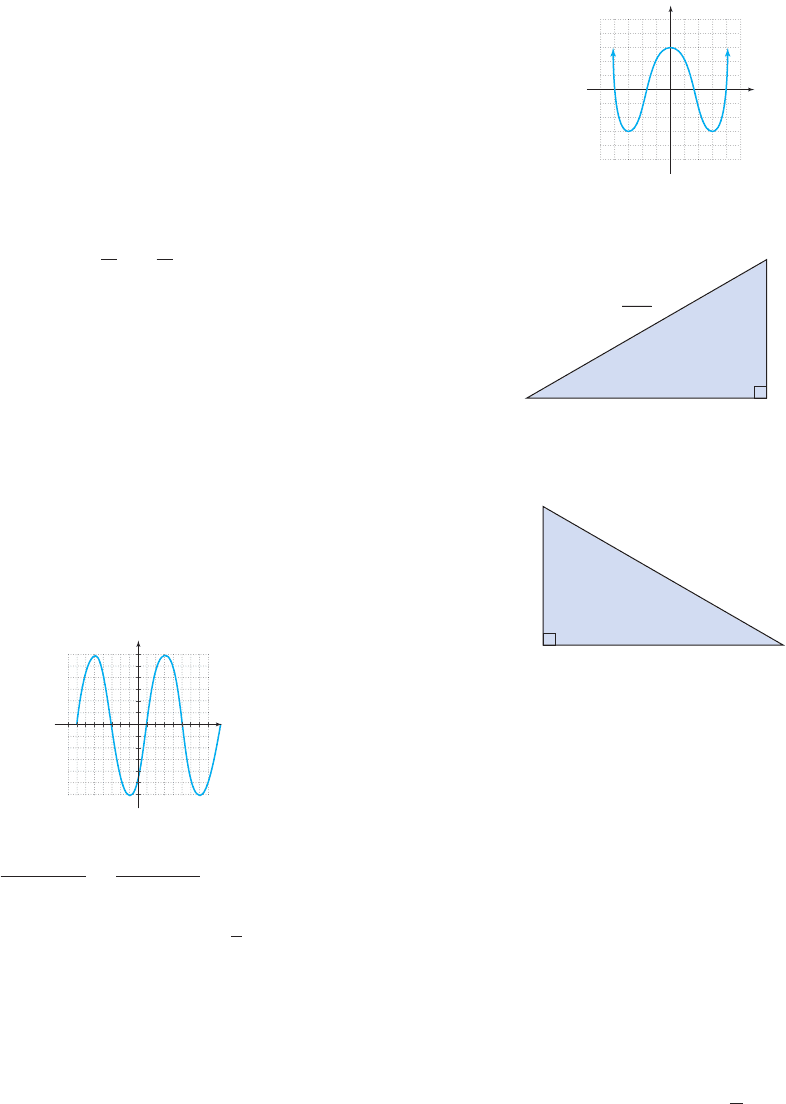
700 CHAPTER 6 Trigonometric Identities, Inverses, and Equations 6-86
College Algebra & Trignometry—
13.
Since 1970, sulphur dioxide emissions in the United
States have been decreasing at a nearly linear rate. In
1970, about 31 million tons were emitted into the
atmosphere. In 2000, the amount had decreased to
approximately 16 million tons. (a) Find a linear
equation that models sulphur dioxide emissions.
(b) Discuss the meaning of the slope ratio in this
context. (c) Use the equation model to estimate the
emissions in 1985, and project the emission for 2010.
Source: 2004 Statistical Abstract of the United States,
Table 360.
14. List the three Pythagorean identities and three
identities equivalent to
15. For what values
of x in satisfy ?
16. Write as a single logarithmic expression in simplest
form:
17. After doing some market research, the manager of a
sporting goods store finds that when a four-pack of
premium tennis balls are priced at $9 per pack,
20 packs per day are sold. For each decrease of
$0.25, 1 additional pack per day will be sold. Find
the price at which four-packs of tennis balls should
be sold in order to maximize the store’s revenue on
this item.
18. Write the equation of the function whose graph is
given, in terms of a sine function.
19. Verify that the following is an
identity:
20. The graph of a function f(x) is shown. Given the
zeroes are and estimate the
following:
a. the domain and range of the function
b. intervals where and f 1x2 0f 1x27 0
x 12
,x 4
cos x 1
tan
2
x
cos x
sec x 1
y
848
6
6
4
x
log1x
2
92 log1x 12 log1x
2
2x 32.
f 1x27 330.530, 22
f1x2 325 cosa
6
x
2
b 168,
cos122.
c. intervals where and
d. name the location of all local maximums and
minimums
21. Use the triangle shown to find the exact value of
22. Use the triangle shown to find the exact value of
23. The amount of waste product released by a
manufacturing company varies according to its
production schedule, which is much heavier during
the summer months and lighter in the winter. Waste
product amount reaches a maximum of 32.5 tons in
the month of July, and falls to a minimum of 21.7
tons in January . (a) Use this information to
build a sinusoidal equation that models the amount
of waste produced each month. (b) During what
months of the year does output exceed 30 tons?
24. At what interest rate will $2500 grow to $3500 if it’s
left on deposit for 6 yr and interest is compounded
continuously?
25. Identify each geometric formula:
a. b.
c. d. y
1
2
bhy 2r
y LWHy r
2
h
1t 12
sin1 2.
sin122.
55
5
3
5
x
y
3
f(x)
f 1x2cf 1x2T
√202
11
9
68
51
cob19529_ch06_691-700.qxd 01/13/2009 10:11 PM Page 700 ssen 1 HD 049:Desktop Folder:Satya 13/01/09:Used file:MHDQ092-6-SUMM:

MWTIII–1 701
Modeling With Technology III Trigonometric Equation Models
In the most common use of the word, a cycle is any series of events or operations that
occur in a predictable pattern and return to a starting point. This includes things as
diverse as the wash cycle on a washing machine and the powers of i. There are a
number of common events that occur in sinusoidal cycles, or events that can be
modeled by a sine wave. As in Section 5.7, these include monthly average tempera-
tures, monthly average daylight hours, and harmonic motion, among many others. Less
well-known applications include alternating current, biorhythm theory, and animal
populations that fluctuate over a known period of years. In this section, we develop
two methods for creating a sinusoidal model. The first uses information about the criti-
cal points (where the cycle reaches its maximum or minimum values), the second
involves computing the equation of best fit (a regression equation) for a set of data.
A. Critical Points and Sinusoidal Models
Although future courses will define them more precisely, we will consider critical
points to be inputs where a function attains a minimum or maximum value. If an event
or phenomenon is known to behave sinusoidally (regularly fluctuating between a
maximum and minimum), we can create an acceptable model of the form
given these critical points (x, y) and the period. For instance,
many weather patterns have a period of 12 months. Using the formula we find
and substituting 12 for P gives (always the case for phenomena with
a 12-month cycle). The maximum value of will always occur
when and the minimum at giving this system
of equations: max value and min value Solving the
system for A and D gives and as before. To find C, assume
the maximum and minimum values occur at (x
2
, M) and (x
1
, m), respectively. We can
substitute the values computed for A, B, and D in along with
either (x
2
, M) or (x
1
, m), and solve for C. Using the minimum value (x
1
, m), where
and , we have
sinusoidal equation model
substitute m for y and x
1
for x
isolate sine function
Fortunately, for sine models constructed from critical points we have
which is always equal to (see Exercise 27). This gives a simple
result for C, since leads to or . See
Exercises 1 through 6 for practice with these ideas.
C
3
2
Bx
1
3
2
Bx
1
C1 sin1Bx
1
C2
1
y D
A
S
m D
A
,
m D
A
sin1Bx
1
C2
m A sin1Bx
1
C2 D
y A sin1Bx C2 D
y mx x
1
y A sin1Bx C2 D,
D
M m
2
A
M m
2
m A112 D.M A112 D
sin1Bx C21,sin1Bx C2 1,
A sin1Bx C2 D
B
6
B
2
P
P
2
B
,
y A sin1Bx C2 D
Learning Objectives
In MWT III you will learn how to:
A. Create a trigonometric
model from critical
points or data
B. Create a sinusoidal
model from data using
regression
College Algebra & Trignometry—
cob19529_ch0MWT_701-710.qxd 12/29/2008 07:59 PM Page 701

EXAMPLE 1
Developing a Model for Polar Ice Cap Area from Critical Points
When the Spirit and Odyssey Rovers landed on Mars (January 2004), there was a
renewed public interest in studying the planet. Of particular interest were the polar
ice caps, which are now thought to hold frozen water, especially the northern cap.
The Martian ice caps expand and contract with the seasons, just as they do here on
Earth but there are about 687 days in a Martian year, making each Martian
“month” just over 57 days long ( ). At its smallest size,
the northern ice cap covers an area of roughly 0.17 million square miles. At the
height of winter, the cap covers about 3.7 million square miles (an area about the
size of the 50 United States). Suppose these occur at the beginning of month
and month respectively.
a. Use this information to create a sinusoidal model of the form
b. Use the model to predict the area of the ice cap in the eighth Martian month.
c. Use a graphing calculator to determine the number of months the cap covers
less than 1 million mi
2
.
Solution
a. Assuming a “12-month” weather pattern, and The maximum
and minimum points are (10, 3.7) and (4, 0.17). Using this information,
and Using
gives The equation model is
where f(x) represents millions of square
miles in month x.
b. For the size of the cap in month 8 we evaluate the function at
substitute 8 for x
result
In month 8, the polar ice cap will cover about 2,817,500 mi
2
.
c. Of the many options available, we opt to solve by locating the points where
and intersect. After entering the
functions on the screen, we set and for a window
with a frame around the output values.
Press (CALC) 5:intersect
to find the intersection points. To four
decimal places they occur at
and The ice cap at the
northern pole of Mars has an area of
less than 1 million mi
2
from early in the
second month to late in the fifth month.
The second intersection is shown in
the figure.
Now try Exercises 7 and 8
x 5.9337.
x 2.0663
TRACE
2nd
y 31, 54x 30, 124
Y =
Y
2
1Y
1
1.765 sin a
6
x
5
6
b 1.935
2.8175
f
182 1.765 sinc
6
182
5
6
d 1.935
x 8.
f
1x2 1.765 sin a
6
x
5
6
b 1.935,
C
3
2
6
142
5
6
.C
3
2
Bx
1
,
A
3.7 0.17
2
1.765.D
3.7 0.17
2
1.935
B
6
.P 12
f
1x2 A sin1Bx C2 D.
10 1x 1024 1x 42
1 Martian day 1 Earth day
702 Modeling With Technology III Trigonometric Equation Models MWTIII–2
1
5
012
College Algebra & Trignometry—
cob19529_ch0MWT_701-710.qxd 01/13/2009 08:01 PM Page 702 ssen 1 HD 049:Desktop Folder:Satya 13/01/09:Used file:Coburn_do_t del-MWTIII:
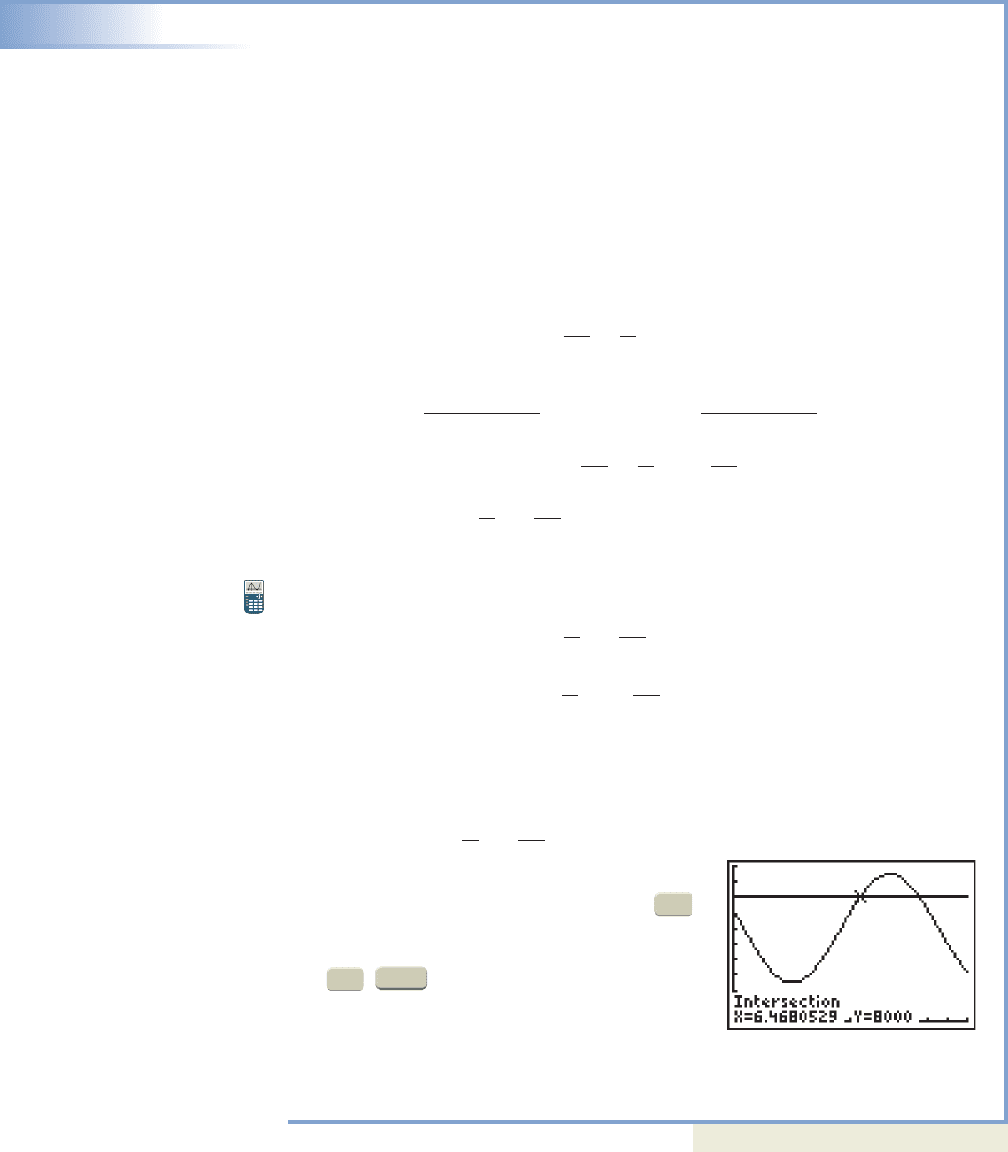
While this form of “equation building” can’t match the accuracy of a regression
model (computed from a larger set of data), it does lend insight as to how sinusoidal
functions work. The equation will always contain the maximum and minimum values,
and using the period of the phenomena, we can create a smooth sine wave that “fills
in the blanks” between these critical points.
EXAMPLE 2
Developing a Model of Wildlife Population from Critical Points
Naturalists have found that many animal populations, such as the arctic lynx, some
species of fox, and certain rabbit breeds, tend to fluctuate sinusoidally over 10-year
periods. Suppose that an extended study of a lynx population began in 2000, and in
the third year of the study, the population had fallen to a minimum of 2500. In the
eighth year the population hit a maximum of 9500.
a. Use this information to create a sinusoidal model of the form
.
b. Use the model to predict the lynx population in the year 2006.
c. Use a graphing calculator to determine the number of years the lynx
population is above 8000 in a 10-year period.
Solution
a. Since we have Using 2000 as year zero, the minimum
and maximum populations occur at (3, 2500) and (8, 9500). From the information
given, and Using the
minimum value we have giving an equation model of
where P(x) represents the lynx
population in year x.
b. For the population in 2006 we evaluate the function at
sinusoidal function model
substitute 6 for x
result
In 2006, the lynx population was about 7082.
c. Using a graphing calculator and the functions
and
we attempt to find points of
intersection. Enter the functions (press )
and set a viewing window (we used
and ). Press
(CALC) 5:intersect to find
where Y
1
and Y
2
intersect. To four decimal
places this occurs at and
The lynx population exceeded
8000 for roughly 3 yr. The first intersection
is shown.
Now try Exercises 9 and 10
x 9.5319.
x 6.4681
TRACE
2nd
y 30, 10,0004x 30, 124
Y =
Y
2
8000,
3500 sin
a
5
x
9
10
b 6000Y
1
7082
P162 3500 sinc
5
162
9
10
d 6000
P1x2 3500 sin
a
5
x
9
10
b 6000
x 6.
P1x2 3500 sin a
5
x
9
10
b 6000,
C
3
2
5
132
9
10
,
A
9500 2500
2
3500.D
9500 2500
2
6000,
B
2
10
5
.P 10,
P1x2 A sin1Bx C2 D
MWTIII–3 Modeling With Technology III Trigonometric Equation Models 703
0
012
10,000
College Algebra & Trignometry—
cob19529_ch0MWT_701-710.qxd 12/29/08 11:49 AM Page 703 epg HD 049:Desktop Folder:NSS_28-12-08:
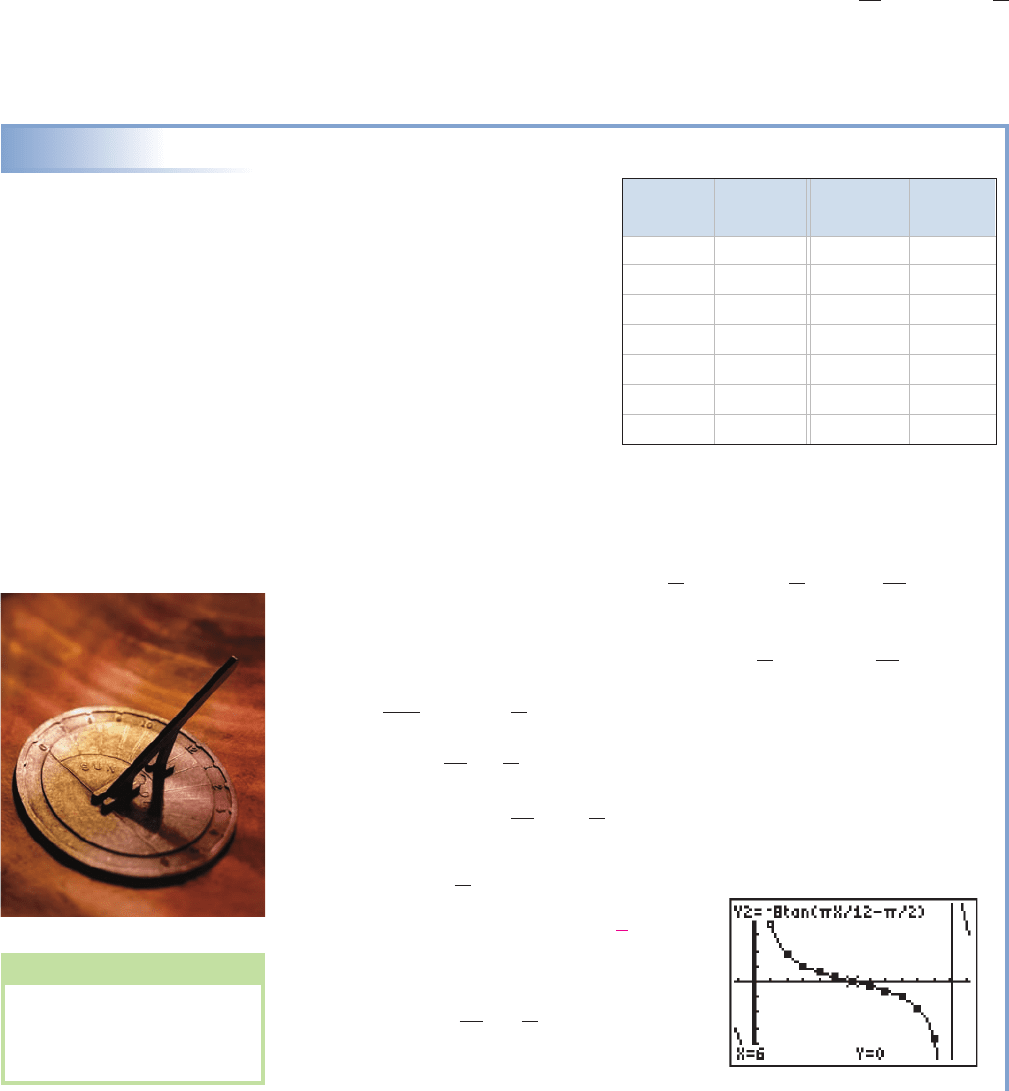
This type of equation building isn’t limited to the sine function, in fact there are
many situations where a sine model cannot be applied. Consider the length of the
shadows cast by a flagpole or radio tower as the Sun makes its way across the sky. The
shadow’s length follows a regular pattern (shortening then lengthening) and “always
returns to a starting point,” yet when the Sun is low in the sky the shadow becomes
(theoretically) infinitely long, unlike the output values from a sine function. In this
case, an equation involving tan x might provide a good model, although the data will
vary greatly depending on latitude. We’ll attempt to model the data using
with the D-term absent since a vertical shift in this context has
no meaning. Recall that the period of the tangent function is and that
gives the magnitude and direction of the horizontal shift, in a direction opposite
the sign.
EXAMPLE 3
Using Data to Develop a Function Model for Shadow Length
The data given tracks the length of a
gnomon’s shadow for the 12 day-
light hours at a certain location near
the equator (positive and negative
values indicate lengths before noon
and after noon respectively).
Assume represents 6:00
A.M.
a. Use the data to find an equation
model of the form
b. Graph the function and scatter-
plot.
c. Find the shadow’s length at 4:30
P.M.
d. If the shadow is 6.1 cm long, what time in the morning is it?
Solution
a. We begin by noting this phenomenon has a period of Using the period
formula for tangent we solve for B: gives so Since we
want (6, 0) to be the “center” of the function [instead of (0, 0)], we desire a
horizontal shift 6 units to the right. Using the ratio gives
so To find A we use the equation built so far:
and any data point to solve for A. Using (3, 8)
we obtain :
simplify
solve for A:
The equation model is
b. The scatter-plot and graph are shown in the
figure.
L1t28 tan
a
12
t
2
b.
tan a
4
b1
8 A
8 A tan
a
4
b
8 A tan
a
12
132
2
b
L1t2 A tan
a
12
t
2
b,
C
2
.6
12C
awith B
12
b
C
B
B
12
.12
B
,P
B
P 12.
L1t2 A tan1Bt C2.
t 0
C
B
P
B
y A tan1Bx C2,
704 Modeling With Technology III Trigonometric Equation Models MWTIII–4
WORTHY OF NOTE
A gnomon is the protruding
feature of a sundial, casting
the shadow used to estimate
the time of day (see photo).
35
35
113
Hour of Length Hour of Length
the Day (cm) the Day (cm)
07
1 29.9 8
2 13.9 9
3 8.0 10
4 4.6 11
5 2.1 12
60
q
29.9
13.9
8.0
4.6
2.1q
College Algebra & Trignometry—
cob19529_ch0MWT_701-710.qxd 12/29/08 11:49 AM Page 704 epg HD 049:Desktop Folder:NSS_28-12-08:
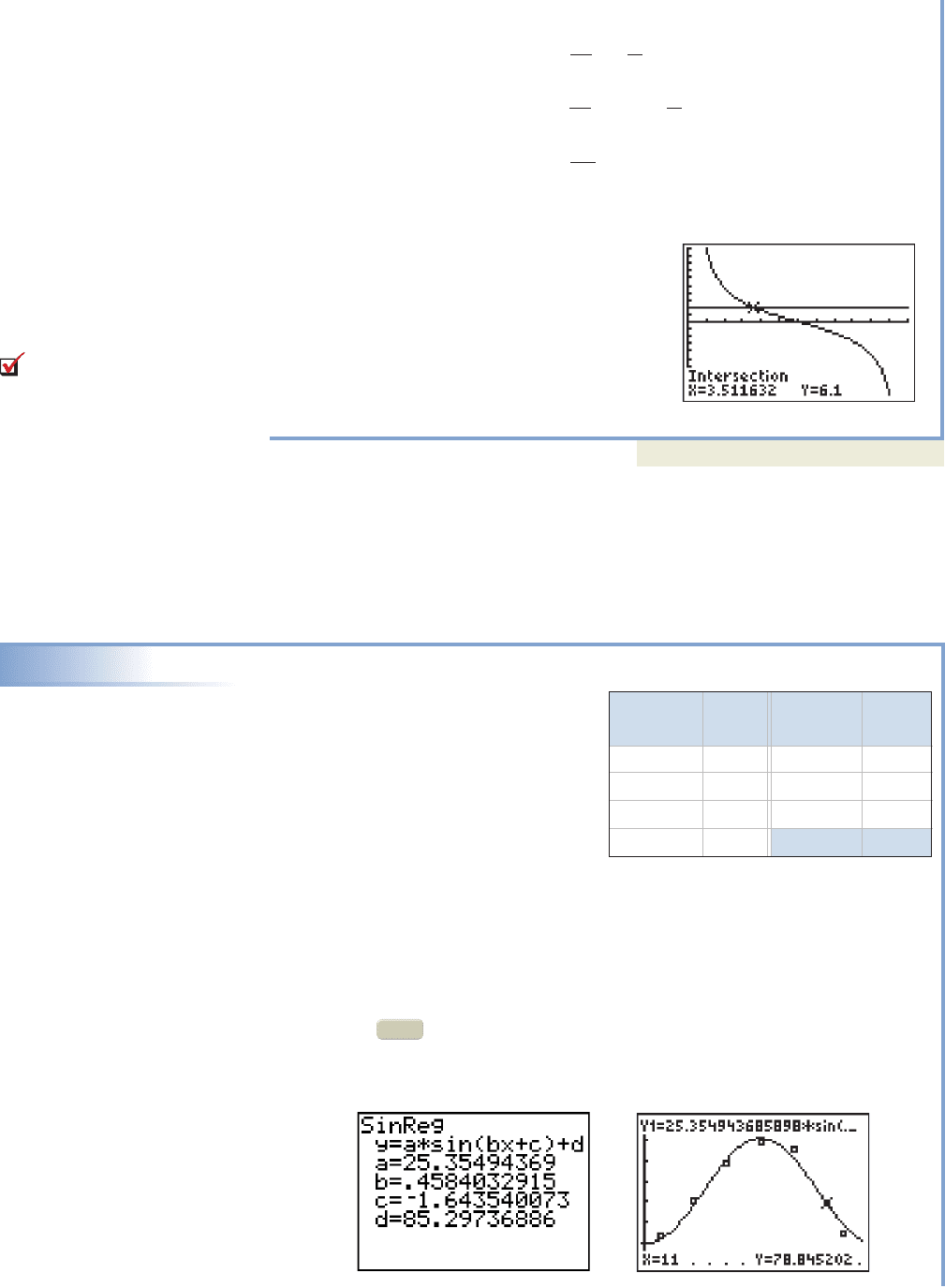
c. 4:30 P.M. indicates Evaluating L(10.5) gives
function model
substitute 10.5 for t
simplify
result
At 4:30
P.M., the shadow has a length of
.
d. Substituting 6.1 for L(t) and solving for t
graphically gives the graph shown, where
we note the day is about 3.5 hr old—it
is about 9:30 A.M.
Now try Exercises 11 and 14
B. Data and Sinusoidal Regression
Most graphing calculators are programmed to handle numerous forms of polynomial
and nonpolynomial regression, including sinusoidal regression.The sequence of steps
used is the same regardless of the form chosen. Exercises 15 through 18 offer further
practice with regression fundamentals. Example 4 illustrates their use in context.
EXAMPLE 4
Calculating a Regression Equation for Seasonal Temperatures
The data shown give the record high
temperature for selected months in
Bismarck, North Dakota.
a. Use the data to draw a scatter-plot,
then find a sinusoidal regression
model and graph both on the same
screen.
b. Use the equation model to estimate
the record high temperatures for months 2, 6, and 8.
c. Determine what month gives the largest difference between the actual data and
the computed results.
Source: NOAA Comparative Climate Data 2004.
Solution
a. Entering the data and running the regression (in radian mode) results in the
coefficients shown in Figure MWT III.1. After entering the equation in Y
1
and
pressing 9:Zoom Stat we obtain the graph shown in Figure MWT III.2
(indicated window settings have been rounded).
ZOOM
19.31
19.31 cm
19.31
8 tan
a
3
8
b
L110.528 tanc
12
110.52
2
d
L1t28 tan
a
12
t
2
b
t 10.5.
MWTIII–5 Modeling With Technology III Trigonometric Equation Models 705
A. You’ve just learned how
to create a trigonometric model
from critical points or data
35
113
35
Figure MWT III.1
55
117
013
Figure MWT III.2
Month Temp. Month Temp.
( ) () ( ) ()
1 63 9 105
3811179
5981265
7 109
°FJan S 1°FJan S 1
College Algebra & Trignometry—
cob19529_ch0MWT_701-710.qxd 12/29/08 11:49 AM Page 705 epg HD 049:Desktop Folder:NSS_28-12-08:
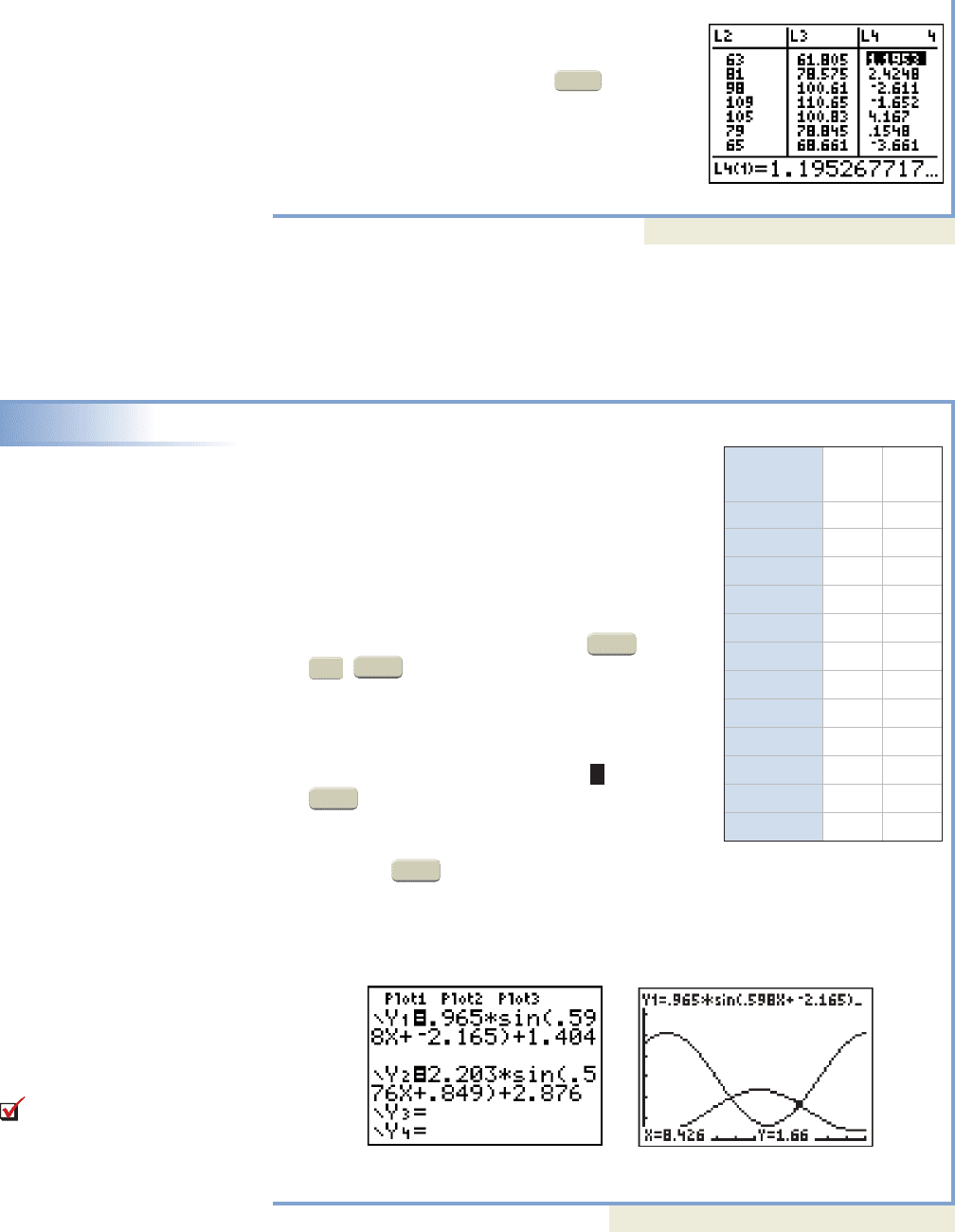
b. Using and as inputs,
projects record high temperatures of
and respectively.
c. In the header of L3, use Y
1
(L1) to evaluate
the regression model using the inputs from L1,
and place the results in L3. Entering in
the header of L4 gives the results shown in
Figure MWT III.3 and we note the largest
difference occurs in September—about .
Now try Exercises 19 and 20
Weather patterns differ a great deal depending on the locality. For example, the
annual rainfall received by Seattle, Washington, far exceeds that received by Cheyenne,
Wyoming. Our final example compares the two amounts and notes an interesting fact
about the relationship.
EXAMPLE 5
Calculating a Regression Model for Seasonal Rainfall
The average monthly rainfall (in inches) for
Cheyenne, Wyoming, and Seattle, Washington, is
shown in the table.
a. Use the data to find a sinusoidal regression
model for the average monthly rainfall in each
city. Enter or paste the equation for Cheyenne in
Y
1
and the equation for Seattle in Y
2
.
b. Graph both equations on the same screen
(without the scatter-plots) and use or
(CALC) 5:intersect
to help estimate the number of months Cheyenne
receives more rainfall than Seattle.
Source: NOAA Comparative Climate Data 2004.
Solution
a. Setting the calculator in Float 0 1 2 3 4 5 6 7 8 9
and running sinusoidal regressions gives
the equations shown in Figure MWT III.4.
b. Both graphs are shown in Figure MWT III.5.
Using the feature, we find the graphs intersect at approximately
(4.7, 2.0) and (8.4, 1.7). While Cheyenne receives far less rainfall each year, it
actually receives more rain than Seattle for about months of
the year.
Now try Exercises 21 through 24
8.4 4.7 3.7
TRACE
MODE
TRACE
2nd
TRACE
4°
L2 L3
ENTER
108.1°,68.5°, 108.0°,
x 8x 2, x 6,
706 Modeling With Technology III Trigonometric Equation Models MWTIII–6
Figure MWT III.4
0
013
7
Figure MWT III.5
Figure MWT III.3
B. You’ve just learned how
to create a sinusoidal model
from data using regression
Month WY WA
(Jan. ) Rain Rain
1 0.45 5.13
2 0.44 4.18
3 1.05 3.75
4 1.55 2.59
5 2.48 1.77
6 2.12 1.49
7 2.26 0.79
8 1.82 1.02
9 1.43 1.63
10 0.75 3.19
11 0.64 5.90
12 0.46 5.62
S 1
College Algebra & Trignometry—
cob19529_ch0MWT_701-710.qxd 12/29/2008 07:10 PM Page 706

MODELING WITH TECHNOLOGY EXERCISES
Find the sinusoidal equation for the information as given.
1. minimum value at (9, 25); maximum value at (3, 75);
period: 12 min
2. minimum value at (4.5, 35); maximum value at
(1.5, 121); period: 6 yr
3. minimum value at (15, 3); maximum value at
(3, 7.5); period: 24 hr
4. minimum value at (3, 3.6); maximum value at
(7, 12); period: 8 hr
5. minimum value at (5, 279); maximum value at
(11, 1285); period: 12 yr
6. minimum value at (6, 8280); maximum value at
(22, 23,126); period: 32 yr
7. Record monthly temperatures: The U.S. National
Oceanic and Atmospheric Administration (NOAA)
keeps temperature records for most major U.S.
cities. For Phoenix, Arizona, they list an average
high temperature of for the month of
January (month 1) and an average high temperature
of for July (month 7). Assuming January
and July are the coolest and warmest months of the
year, (a) build a sinusoidal function model for
temperatures in Phoenix, and (b) use the model to
find the average high temperature in September.
(c) If a person has a tremendous aversion to
temperatures over during what months should
they plan to vacation elsewhere?
8. Seasonal size of polar ice caps: Much like the
polar ice cap on Mars, the sea ice that surrounds
the continent of Antarctica (the Earth’s southern
95°,
104.2°F
65.0°F
polar cap) varies seasonally, from about 8 million
mi
2
in September to about 1 million mi
2
in March.
Use this information to (a) build a sinusoidal
equation that models the advance and retreat of the
sea ice, and (b) determine the size of the ice sheet
in May. (c) Find the months of the year that the sea
ice covers more than 6.75 million mi
2
.
9. Body temperature cycles:A phenomenon is said
to be circadian if it occurs in 24-hr cycles. A
person’s body temperature is circadian, since there
are normally small, sinusoidal variations in body
temperature from a low of to a high of
throughout a 24-hr day. Use this information to
(a) build the circadian equation for a person’s body
temperature, given corresponds to midnight
and that a person usually reaches their minimum
temperature at 5
A.M.; (b) find the time(s) during a
day when a person reaches “normal” body
temperature and (c) find the number of hours
each day that body temperature is or less.
10. Position of engine piston: For an internal
combustion engine, the position of a piston in the
cylinder can be modeled by a sinusoidal function.
For a particular engine size and idle speed, the
piston head is 0 in. from the top of the cylinder (the
minimum value) when at the beginning of
the intake stroke, and reaches a maximum distance
of 4 in. from the top of the cylinder (the maximum
value) when sec at the beginning of the
compression stroke. Following the compression
stroke is the power stroke the exhaust
stroke and the intake stroke after
which it all begins again. Given the period of a
four-stroke engine under these conditions is
second, (a) find the sinusoidal equation
modeling the position of the piston, and (b) find
the distance of the piston from the top of the
cylinder at sec. Which stroke is the engine in
at this moment?
t
1
9
P
1
24
1t
4
48
2,1t
3
48
2,
1t
2
48
2,
t
1
48
t 0
98.4°F
198.6°2;
t 0
99°F98.2°F
Ice caps
mininum
maximum
0
Intake
1
2
3
4
0
1
2
3
4
0
1
2
3
4
0
1
2
3
4
Compression
MWTIII–7 Modeling With Technology III Trigonometric Equation Models 707
College Algebra & Trignometry—
cob19529_ch0MWT_701-710.qxd 12/29/08 11:49 AM Page 707 epg HD 049:Desktop Folder:NSS_28-12-08:

Data and tangent functions: Use the data given to find an
equation model of the form Then
graph the function and scatter plot to help find (a) the
output for and (b) the value of x where .
11.
12.
f1x2 16x 2.5,
f1x2 A tan1Bx C2.
13. Distance and
apparent height:
While driving toward
a Midwestern town
on a long, flat stretch
of highway, I decide
to pass the time by
measuring the
apparent height of
the tallest building in
the downtown area
as I approach. At the
time the idea
occurred to me, the buildings were barely visible.
Three miles later I hold a 30-cm ruler up to my
eyes at arm’s length, and the apparent height of the
tallest building is 1 cm. After three more miles the
apparent height is 1.8 cm. Measurements are taken
every 3 mi until I reach town and are shown in the
table (assume I was 24 mi from the parking garage
when I began this activity). (a) Use the data to
come up with a tangent function model of the
building’s apparent height after traveling a distance
of x mi closer. (b) What was the apparent height of
the building at after I had driven 19 mi? (c) How
many miles had I driven when the apparent height
of the building took up all 30 cm of my ruler?
708 Modeling With Technology III Trigonometric Equation Models MWTIII–8
xy xy
1 2.1
2 6.8
3 15.3
4 25.4
4.5 59
00
1.91
7.22
14.83
264
614.5
After years
of movement
Elastic
rebound
POP!
Fault line
Stress line
Start
(0, 0)
14. Earthquakes and elastic rebound: The theory of
elastic rebound has been used by seismologists to
study the cause of earthquakes. As seen in the
figure, the Earth’s crust is stretched to a breaking
point by the slow movement of one tectonic plate
in a direction opposite the other along a fault line,
and when the rock snaps—each half violently
rebounds to its original alignment causing the
Earth to quake.
Suppose the misalignment of these plates through
the stress and twist of crustal movement can be
modeled by a tangent graph, where x represents the
horizontal distance from the original stress line,
and y represents the vertical distance from the fault
line. Assume a “period” of 10.2 m. (a) Use the data
from the table on page 141 to come up with a
trigonometric model of the deformed stress line.
(b) At a point 4.8 m along the fault line, what is the
distance to the deformed stress line (moving
parallel to the original stress line)? (c) At what
point along the fault line is the vertical distance to
the deformed stress line 50 m?
Data and sinusoidal regression models: For the
following sets of data (a) find a sinusoidal regression
equation using your calculator; (b) construct an equation
manually using the period and maximum/minimum values;
xy xy
07
120 8
2 9.7 9
3 5.2 10
4311
5 1.4 12
60
q
20
9.7
5.2
3
1.4q
xy xy
0 7 6.4
1 8 13.7
2 9 23.7
3 10 44.3
4 11 91.3
512
60
q6.4
13.7
23.7
44.3
91.3
q
Distance Height
Traveled (mi) (cm)
00
31
6 1.8
9 2.8
12 4.2
15 6.3
18 10
21 21
24 q
College Algebra & Trignometry—
cob19529_ch0MWT_701-710.qxd 12/29/2008 06:13 PM Page 708

19. Record monthly
temperatures: The
highest temperature of
record for the even
months of the year are
given in the table for
the city of Pittsburgh,
Pennsylvania. (a) Use
the data to draw a
scatter-plot, then find a
sinusoidal regression model and graph both on the
same screen. (b) Use the equation to estimate the
record high temperature for the odd-numbered
months. (c) What month shows the largest
difference between the actual data and the
computed results?
Source: 2004 Statistical Abstract of the United States, Table 378.
20. River discharge rate: The average discharge rate
of the Alabama River is given in the table for the
odd-numbered months of the year. (a) Use the data
to draw a scatter-plot,
then find a sinusoidal
regression model and
graph both on the same
screen. (b) Use the
equation to estimate
the flow rate for the
even-numbered
months. (c) Use the
graph and equation to
estimate the number of days per year the flow rate
is below 500 m
3
/sec.
Source: Global River Discharge Database Project;
www.rivdis.sr.unh.edu.
21. Average monthly rainfall: The average monthly
rainfall (in inches) for Reno, Nevada, is shown in
the table. (a) Use the data to find a sinusoidal
regression model for the monthly rainfall. (b) Graph
this equation model and the rainfall equation model
for Cheyenne, Wyoming (from Example 5), on the
same screen, and estimate the number of months
that Reno gets more rainfall than Cheyenne.
Source: NOAA Comparative Climate Data 2004.
and (c) graph both on the same screen, then use a TABLE
to find the largest difference between output values.
15. 16.
MWTIII–9 Modeling With Technology III Trigonometric Equation Models 709
Day of
Month Output
115
441
769
10 91
13 100
16 90
19 63
22 29
25 5
28 2
31 18
Day of
Month Output
1 179
4 201
7 195
10 172
13 145
16 120
19 100
22 103
25 124
28 160
31 188
Month
( ) Output
116
219
321
422
521
619
716
813
911
10 10
11 11
12 13
Jan. 1
Month
( ) Output
186
296
399
495
583
672
756
848
943
10 49
11 58
12 73
Jan. 1
17. 18.
22. Hours of daylight by month: The number of
daylight hours per month (as measured on the 15th
of each month) is shown in the table for the cities
of Beaumont,
Texas, and
Minneapolis,
Minnesota.
(a) Use the data
to find a
sinusoidal
regression
model of the
daylight hours
for each city.
(b) Graph both
equations on the
same screen and
use the graphs to
estimate the
number of days
each year that Beaumont receives more daylight
than Minneapolis (use ).
Source: www.encarta.msn.com/media_701500905/
Hours_of_Daylight_by_Latitude.html.
30.5 days1 month
Month High
(Jan. ) Temp. ( )
276
489
698
8 100
10 87
12 74
°FS 1
Month Reno Month Reno
( ) Rainfall ( ) Rainfall
1 1.06 7 0.24
2 1.06 8 0.27
3 0.86 9 0.45
4 0.35 10 0.42
5 0.62 11 0.80
6 0.47 12 0.88
Jan S 1Jan S 1
Month TX MN
( ) Sunlight Sunlight
1 10.4 9.1
2 11.2 10.4
3 12.0 11.8
4 12.9 13.5
5 14.4 16.2
6 14.1 15.7
7 13.9 15.2
8 13.3 14.2
9 12.4 12.6
10 11.5 11.0
11 10.7 9.6
12 10.2 8.7
Jan S 1
Month Rate
(Jan. ) (m
3
/sec)
1 1569
3 1781
5 1333
7 401
9 261
11 678
S 1
College Algebra & Trignometry—
cob19529_ch0MWT_701-710.qxd 12/29/08 11:49 AM Page 709 epg HD 049:Desktop Folder:NSS_28-12-08:
